My first encounter with the Adirondack Guideboat Company (AGB) was at an art fair during a summer visit to Vermont. Coming from the Midwest, I’d never seen or heard of a guideboat; their cedar 15-footer was the most beautiful boat I’d ever seen. My wife and I bought one of AGB's navy-blue Kelvar guideboats as a “retirement present” and for 12 years I rowed it on lakes and streams and rivers throughout the Indiana countryside.We moved to Vermont, and as time passed and the AGB catalogs kept appearing, I was drawn to the company’s newest boat in their line of rowing craft, the Vermont Dory, a 14′ flat-bottomed double-ender. One day, giving in to longing rather than need, I drove to AGB’s North Ferrisburgh shop to check it out. In their lobby sat a magnificent Vermont Dory, with spruce-green sides, cherry gunwales and decks, woven rush seats, and furniture-quality 7′ cherry oars with wonderful grain-swirls in the blade ends. I bought it on the spot and rowed it that day. When I pole-pushed off from the shore, the Vermont Dory softly drifted into a lengthy glide while I slid the brass oar pins into the oarlocks. Then, with the first reach-and-pull on the oars, the Vermont Dory went out into the river quickly, quietly, effortlessly, and straight. I blissfully made a nearly two-hour maiden voyage. The Vermont Dory is a 14′ double-ender based on Adirondack guideboats dating to the 1800s. The bottom of the hull has a flat to keep it upright when beached. The wide, low chines contribute to the boat's reassuring stability.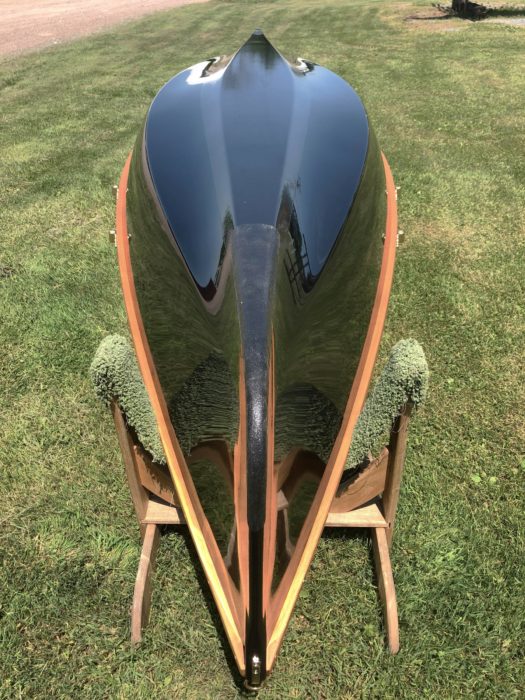 Photographs courtesy of Adirondacks Guideboats
Photographs courtesy of Adirondacks Guideboats
Join The Conversation
We welcome your comments about this article. If you’d like to include a photo or a video with your comment, please email the file or link.


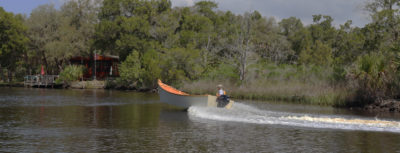
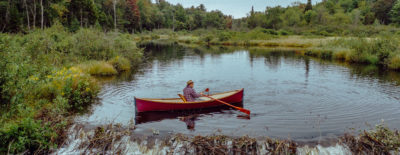
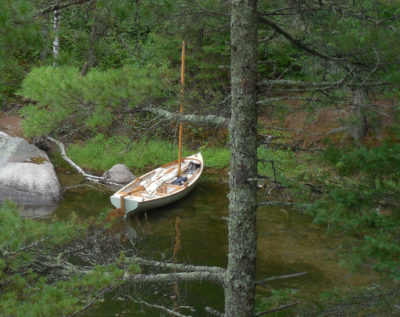
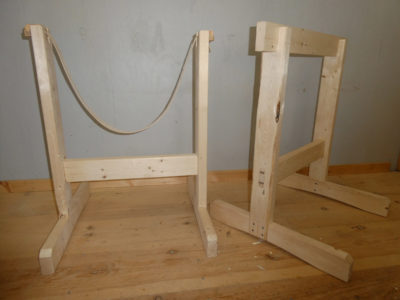
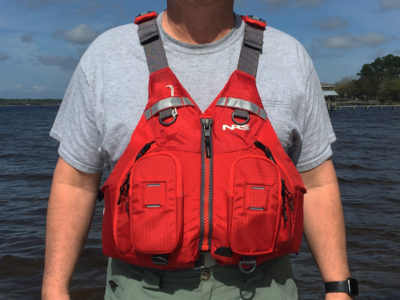
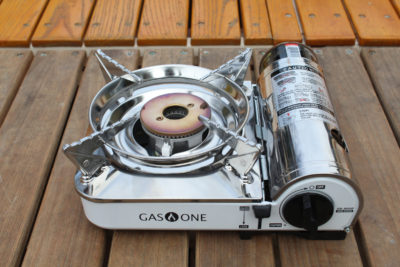
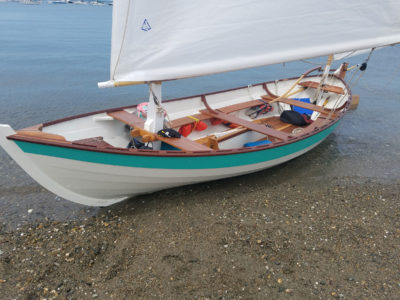
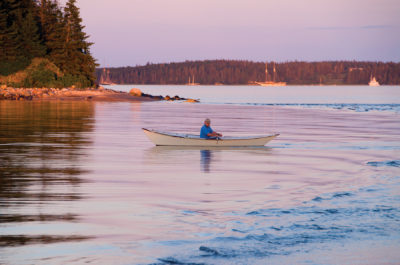
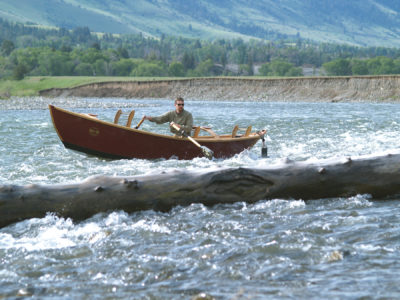
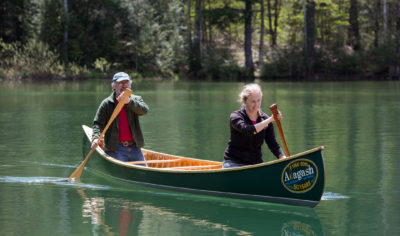
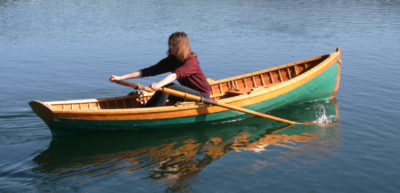
Can I get the plans for this boat or is it something I could build?
Evan B.
We offer a kit for the traditional Guide Boat but, unfortunately we don’t offer it in the 14′ Vermont Fishing Dory.
Very nice article. Great-looking boat. I particularly enjoyed hearing how the author has been using his dory.
Thanks for your comment! The Dory is our best selling boat and this article really gives a great explanation of our boat!
Thanks for sharing your Vermont Dory story, Mike. Three years ago, a move from upcountry Maine to Portland necessitated a pruning of a number of wood canvas canoes of all ages and a 17′ Rangeley guideboat double-ender, my long-time companion on many a camping and fishing trip on lakes in western Maine, particularly the chain of lakes bearing her name. In honor of that heritage, the Rangeley was donated to the Rangeley Region Outdoor Sporting Heritage Museum. Boatless for the first time in seven decades, I searched or a replacement of the Rangeley, but advancing years meant something lighter and more easily stored in the yard in Portland. Having rowed an AGB demo guideboat loaned by Steve Kulback at a summer event in Rockland, Maine, years ago, the joy derived in just fifteen minutes of running “anchorage slalom” lodged well in my memory cells, which led to a call to AGB the spring after the move to Portland. A spanking new red boat was on special sale, due to a slight color problem in the gel coat in one small place below the water line. A month later, Steve assisted Ian and Justin Martin by delivering it to our pond-side camp in western New Hampshire. A matter of love at first row, it, was promptly named MISS SCARLET, the vamp of CLUE. Since, then, she has been the perfect successor to my beloved Rangeley. Preferring to feather the spruce Shaw and Tenney 7’6″ oars that were included in the sale, I stitched leathers, and buttons to go with brass ring oarlocks rather than go with pinned looms. Other than the excellent layup, trim and all ’round beauty, her best sea-keeping feature is the configuration of her bottom, hence her name. The flat tapered shoe lying between concave sections and hard chines provide three bottoms in a way; one flat, two concave. The combination allows for easy speed, stability and excellent tracking for a keel-less boat weighing only 80 lbs. Her splayed dory sides keep her dry in a chop. On the pond or along the Casco Bay shore MISS SCARLET is the girl for me.
Love this! Ian and I are so glad you love your boat!
Wonderful. Thoughtful touches to a classic. 14 foot seems to be a sweet spot for friendly small boats that have great utility, and 80 pounds was a pleasant surprise. We restore a lot of boats and that weight is a good fit for our “wiser” customers, as well as families with kiddos. We also like the small business aspect of AGB.
You’re right, the 14’ Dory suits a lot of people’s needs, especially if stability is needed because of bad knees or for your young kids.
Thanks for the nice words!
Beautiful boat!! I would like to see how the rowing foot rests attach to floor boards. I have completed a rowing tender and was needing something like that.
A picture would be most appreciated
Thanks
The foot brace is held down with pins on the underside of the front part of the foot brace and the back part is held down with a brass T-bolt.
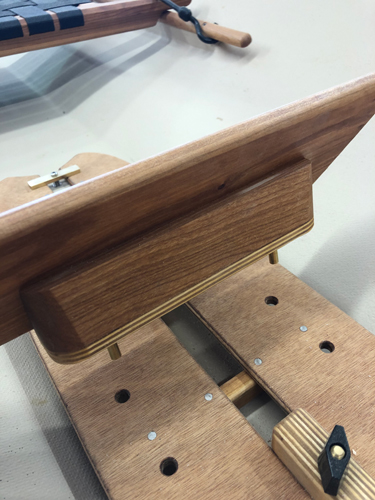
Sincerely,
Justin Martin
Adirondack Guide Boat
I bought the Vermont Dory 14 two years ago. I don‘t know how it rows because I only sail her here on Lake Constance. It is a excellent sailor, even with very little wind. I did a lot of modifying by the time. My latest adding is a small retractable e-motor (about 300 W). Great boat!
PS: Why not rowing it? Because I am so fond of my canoe with a Frontrower device.
As a small-boat sailor (I have a 15′ Delaware Ducker) and rower I would much appreciate info. On how you rigged her for sailing.
Thanks,
Alton Stone
I’m going on to my third season with my Vermont Dory and absolutely love it. It’s home is on a 1300-acre lake in near Nisswa, Minnesota. To me it feels like you are sitting in a sports car. One thing I like about it when rowing is that it holds a straight track very well and you are not wandering around, always making a correction on your course. There is a sliding-seat accessory you can put in place of the bench seat and using this gives me an increase of about one mile an hour of speed. I usually row a stroke rate of about 28 strokes per minute and this will give me an average speed of about 3.5 miles per hour.
Having built a couple of sailing rigs for our wood/canvas canoes, and having seen pictures of the one used on the Vermont Dory and in Todd Bradshaw’s book, Canoe Rig, the Essence and the Art, last spring I built a unified drop-in unit of cherry and a side-saddle clamp-on rudder with a push/pull tiller. I’ll use my canoe leeboards and a Dabbler Sails 50 sq. ft. lateen canoe rig. I think it will do the job. Has anyone out there used a lateen rig with a Vermont Dory?
It’s been a six-year love affair with my Vermont Dory. I’d never rowed before but wanted something that I could take my dog in and still explore bays and places like the MITA territory. I’ve always kayaked, but a dog in the cockpit limited me to calm waters. This craft has hit the sweet spot for me! Countless hours have been spent rowing it grinning ear-to-ear. As mentioned previously, be prepared for another eye-roll from your spouse, as another person stops to ask you about your beautiful boat!
So fine, so fine! A proper boat in every way. Life’s too short to not have a pretty boat. And a loving wife!